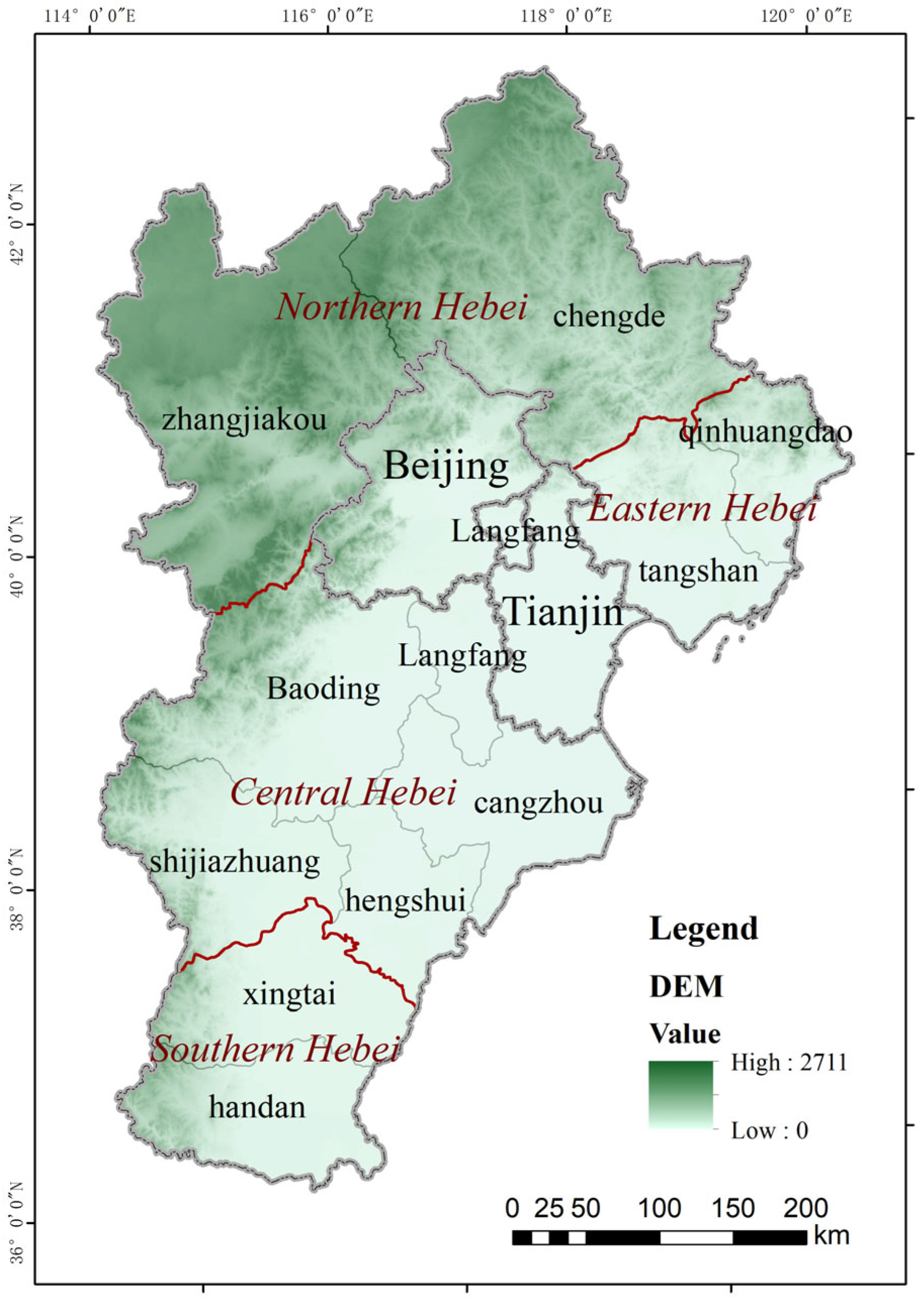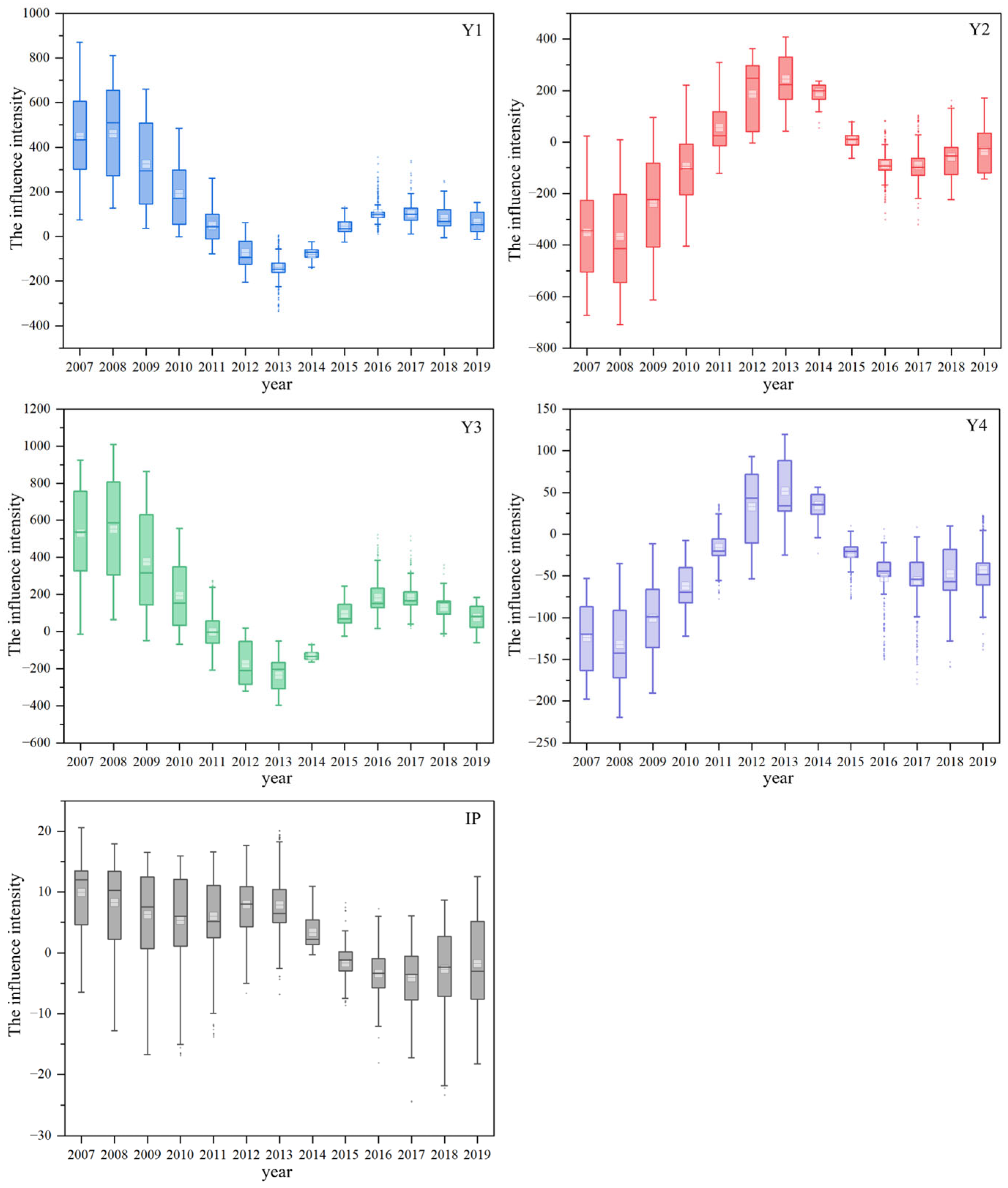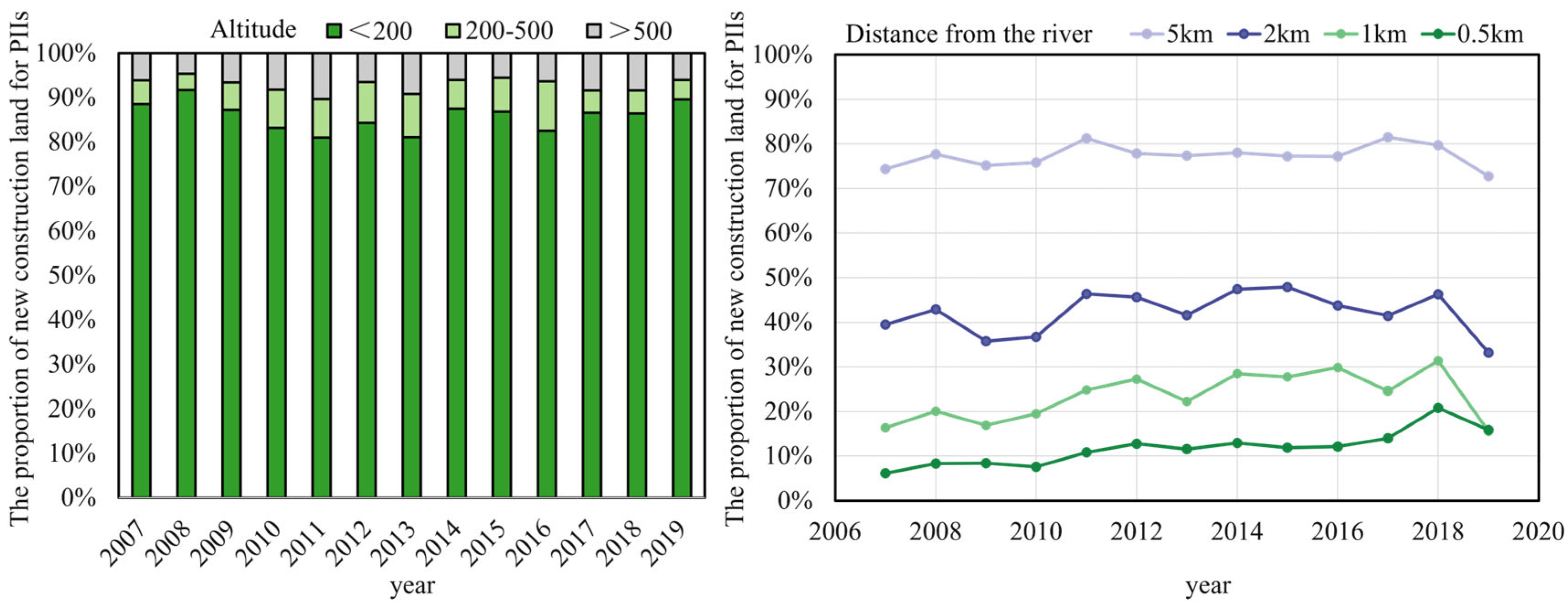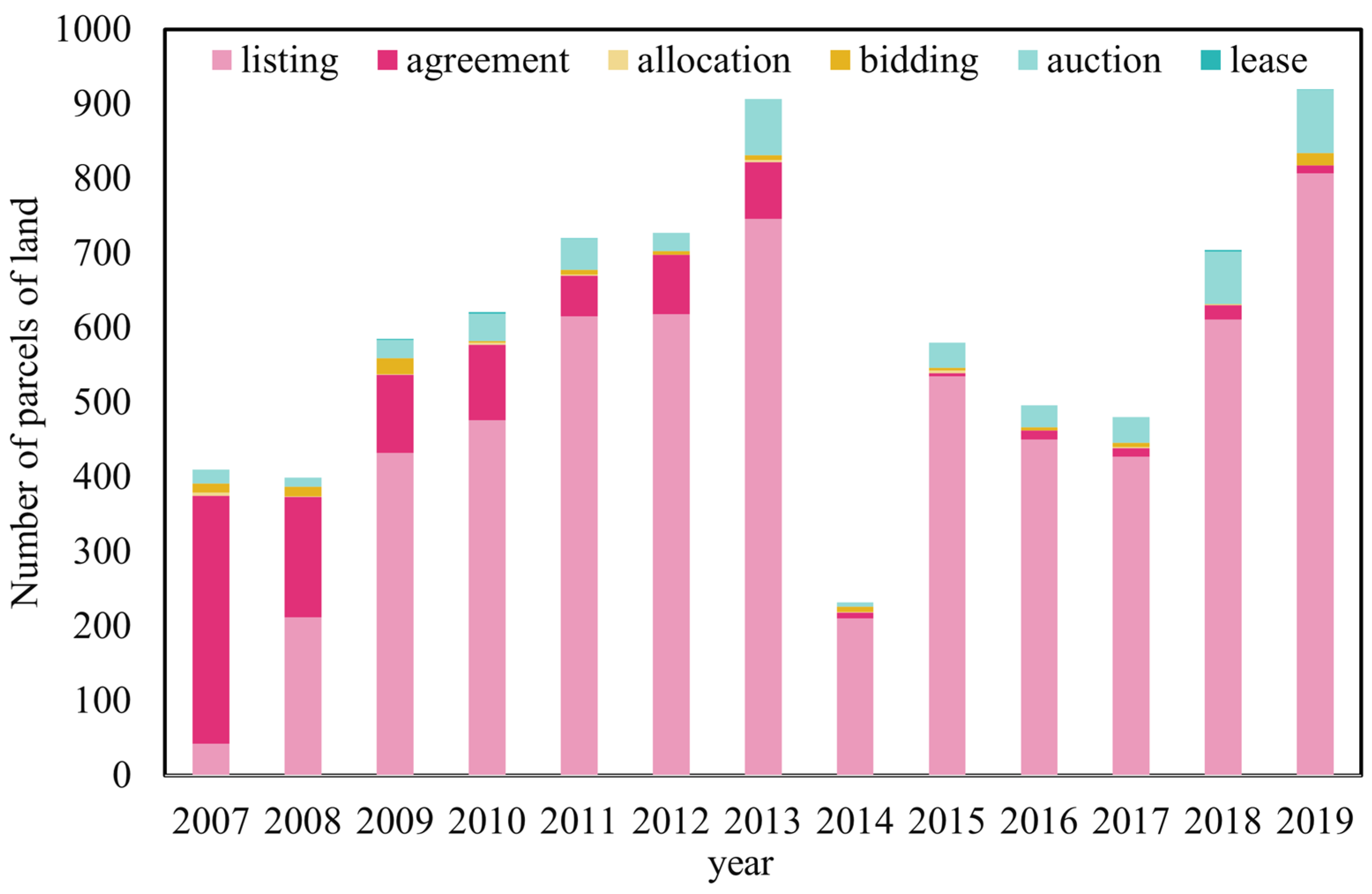From “Policy-Driven” to “Park Clustering”: Evolution and Attribution of Location Selection for Pollution-Intensive Industries in the Beijing–Tianjin–Hebei Urban Agglomeration
Abstract
1. Introduction
2. Materials and Methods
2.1. Study Area
2.2. Data Sources and Definitions
2.3. Methods
2.3.1. Theoretical Framework for Determinants of PII Location
2.3.2. Model of Influence Factors
2.3.3. Spatial Correlation Analysis and Principal Component Analysis (PCA)
2.3.4. GTWR
3. Results
3.1. Analysis of Temporal Heterogeneity of Influencing Factors
3.2. Analysis of Spatial Heterogeneity of Influencing Factors
4. Discussion
4.1. The Impact of Geographical Location on the Distribution of PIIs Gradually Weakens
4.2. PIIs Gradually Shifted Toward Areas with Moderate Economic Levels
4.3. Government Intervention: Dominant but Gradually Weakening
4.4. Limitations and Future Research Directions
5. Conclusions
Author Contributions
Funding
Data Availability Statement
Conflicts of Interest
References
- Li, H.; Lu, J.; Li, B. Does pollution-intensive industrial agglomeration increase residents’ health expenditure? Sustain. Cities Soc. 2020, 56, 102092. [Google Scholar] [CrossRef]
- Chen, W.; Shen, Y.; Wang, Y.; Wu, Q. How do industrial land price variations affect industrial diffusion? Evidence from a spatial analysis of China. Land Use Policy 2018, 71, 384–394. [Google Scholar] [CrossRef]
- Du, G.; Liu, S.; Lei, N.; Huang, Y. A test of environmental Kuznets curve for haze pollution in China: Evidence from the panel data of 27 capital cities. J. Clean. Prod. 2018, 205, 821–827. [Google Scholar] [CrossRef]
- Wang, Y.; Duan, X.; Wang, L.; Zou, H. Spatial temporal patterns and driving factors of industrial pollution and structures in the Yangtze River Economic Belt. Chemosphere 2022, 303, 134996. [Google Scholar] [CrossRef]
- Badri, M. Dimensions of industrial location factors: Review and exploration. J. Bus. Public Aff. 2007, 1, 1–26. [Google Scholar]
- Wu, H.; Guo, H.; Zhang, B.; Bu, M. Westward movement of new polluting firms in China: Pollution reduction mandates and location choice. J. Comp. Econ. 2017, 45, 119–138. [Google Scholar] [CrossRef]
- Wang, Q.; Wang, Y.; Chen, W.; Zhou, X.; Zhao, M.; Zhang, B. Do land price variation and environmental regulation improve chemical industrial agglomeration? A regional analysis in China. Land Use Policy 2020, 94, 104568. [Google Scholar] [CrossRef]
- Dean, J.M.; Lovely, M.E.; Wang, H. Are foreign investors attracted to weak environmental regulations? Evaluating the evidence from China. J. Dev. Econ. 2009, 90, 1–13. [Google Scholar] [CrossRef]
- Shen, J.; Wei, Y.D.; Yang, Z. The impact of environmental regulations on the location of pollution-intensive industries in China. J. Clean. Prod. 2017, 148, 785–794. [Google Scholar] [CrossRef]
- Ahmad, M.; Jabeen, G.; Wu, Y. Heterogeneity of pollution haven/halo hypothesis and Environmental Kuznets Curve hypothesis across development levels of Chinese provinces. J. Clean. Prod. 2021, 285, 124898. [Google Scholar] [CrossRef]
- Hu, J.; Liang, J.; Fang, J.; He, H.; Chen, F. How do industrial land price and environmental regulations affect spatiotemporal variations of pollution-intensive industries? Regional analysis in China. J. Clean. Prod. 2022, 333, 130035. [Google Scholar] [CrossRef]
- Liu, W.; Shen, J.; Wei, Y.D. Spatial restructuring of pollution-intensive enterprises in Foshan China: Effects of the changing role of environmental regulation. J. Environ. Manag. 2023, 325, 116501. [Google Scholar] [CrossRef] [PubMed]
- Ma, S.; Wang, L.; Wang, H.; Zhang, X.; Jiang, J. Spatial heterogeneity of ecosystem services in response to landscape patterns under the Grain for Green Program: A case-study in Kaihua County, China. Land Degrad. Dev. 2022, 33, 1901–1916. [Google Scholar] [CrossRef]
- Bu, Y.; Wang, E.; Jiang, Z. Evaluating spatial characteristics and influential factors of industrial wastewater discharge in China: A spatial econometric approach. Ecol. Indic. 2021, 121, 107219. [Google Scholar] [CrossRef]
- Tu, W.; Rao, C.; Xiao, X.; Hu, F.; Goh, M. Interactive geographical and temporal weighted regression to explore spatio-temporal characteristics and drivers of carbon emissions. Environ. Technol. Innov. 2024, 36, 103836. [Google Scholar] [CrossRef]
- Liu, J.; Diamond, J. China’s environment in a globalizing world. Nature 2005, 435, 1179–1186. [Google Scholar] [CrossRef]
- Li, R.; Ramanathan, R. Exploring the relationships between different types of environmental regulations and environmental performance: Evidence from China. J. Clean. Prod. 2018, 196, 1329–1340. [Google Scholar] [CrossRef]
- Kong, W.; Shen, W.C.; Yu, C.Y.; Niu, L.; Zhou, H.X.; Zhang, Z.F.; Guo, S. The neglected cost: Ecosystem services loss due to urban expansion in China from a triple-coupling perspective. Environ. Impact Assess. Rev. 2025, 112, 107827. [Google Scholar] [CrossRef]
- Zhang, G.; Liu, W.; Duan, H. Environmental regulation policies, local government enforcement and pollution-intensive industry transfer in China. Comput. Ind. Eng. 2020, 148, 106748. [Google Scholar] [CrossRef]
- Hu, J.; Liu, Y.; Fang, J.; Jing, Y.; Liu, Y.; Liu, Y. Characterizing pollution-intensive industry transfers in China from 2007 to 2016 using land use data. J. Clean. Prod. 2019, 223, 424–435. [Google Scholar] [CrossRef]
- Chen, L.; Xu, L.; Yang, Z. Accounting carbon emission changes under regional industrial transfer in an urban agglomeration in China’s Pearl River Delta. J. Clean. Prod. 2017, 167, 110–119. [Google Scholar] [CrossRef]
- Wang, H.; Dong, C.; Liu, Y. Beijing direct investment to its neighbors: A pollution haven or pollution halo effect? J. Clean. Prod. 2019, 239, 118062. [Google Scholar] [CrossRef]
- Fu, S.; Ma, Z.; Ni, B.; Peng, J.; Zhang, L.; Fu, Q. Research on the spatial differences of pollution-intensive industry transfer under the environmental regulation in China. Ecol. Indic. 2021, 129, 107921. [Google Scholar] [CrossRef]
- Luo, Y.; Zhou, D.; Tian, Y.; Jiang, G. Spatial and temporal characteristics of different types of pollution-intensive industries in the Beijing-Tianjin-Hebei region in China by using land use data. J. Clean. Prod. 2021, 329, 129601. [Google Scholar] [CrossRef]
- Chinese Academy of Sciences. Resource and Environment Science Data Center. Available online: http://www.resdc.cn/ (accessed on 4 June 2022).
- National Development and Reform Commission; Ministry of Science and Technology; Ministry of Natural Resources; Ministry of Housing and Urban-Rural Development; Ministry of Commerce; General Administration of Customs of the People’s Republic of China. China Development Zone Audit and Announcement Catalog (2018 Edition). 2018. Available online: https://www.gov.cn/zhengce/zhengceku/2018-12/31/content_5434045.htm (accessed on 4 June 2022).
- China Land Market Network. Available online: https://www.landchina.com/#/ (accessed on 4 June 2022).
- Bingham, R.D.; Mier, R. Theories of Local Economic Development: Perspectives from Across the Disciplines; SAGE: Newcastle upon Tyne, UK, 1993. [Google Scholar]
- Harkness, J. Factor Abundance and Comparative Advantage. Am. Econ. Rev. 1978, 68, 784–800. [Google Scholar]
- Zheng, F.; Niu, Y. Environmental Decentralization, Resource Endowment and Urban Industrial Transformation and Upgrading: A Comparison of Resource-Based and Non-Resource-Based Cities in China. Sustainability 2023, 15, 10475. [Google Scholar] [CrossRef]
- Arvanitopoulos, T.; Monastiriotis, V.; Panagiotidis, T. Drivers of convergence: The role of first- and second-nature geography. Urban Stud. 2021, 58, 2880–2900. [Google Scholar] [CrossRef]
- Wu, Z.; Woo, S.-H.; Lai, P.-L.; Chen, X. The economic impact of inland ports on regional development: Evidence from the Yangtze River region. Transp. Policy 2022, 127, 80–91. [Google Scholar] [CrossRef]
- Lu, C.; Ouyang, Q. Environmental regulation and urban position in the inter-urban pollution transfer network: A perspective on network analysis of pollution-intensive enterprises’ relocation. J. Clean. Prod. 2024, 435, 140418. [Google Scholar] [CrossRef]
- Zhang, C.; Tao, R.; Yue, Z.; Su, F. Regional competition, rural pollution haven and environmental injustice in China. Ecol. Econ. 2023, 204, 107669. [Google Scholar] [CrossRef]
- Su, L. Environmental regulation and corporate green innovation: Evidence from the implementation of the total energy consumption target in China. J. Bus. Econ. 2025, 95, 499–526. [Google Scholar] [CrossRef]
- Bai, Y.; Hua, C.; Jiao, J.; Yang, M.; Li, F. Green efficiency and environmental subsidy: Evidence from thermal power firms in China. J. Clean. Prod. 2018, 188, 49–61. [Google Scholar] [CrossRef]
- He, C.; Wei, Y.D.; Xie, X. Globalization, Institutional Change, and Industrial Location: Economic Transition and Industrial Concentration in China. Reg. Stud. 2008, 42, 923–945. [Google Scholar] [CrossRef]
- Yin, K.; Miao, Y.; Huang, C. Environmental regulation, technological innovation, and industrial structure upgrading. Energy Environ. 2024, 35, 207–227. [Google Scholar] [CrossRef]
- Choi, G. Determinants of target location selection for acquirers in the manufacturing sector: Pollution intensity, policy enforcement, and civic environmentalism. J. Bus. Res. 2022, 146, 308–324. [Google Scholar] [CrossRef]
- Guo, Y.; Tian, J.; Chen, L. Managing energy infrastructure to decarbonize industrial parks in China. Nat. Commun. 2020, 11, 981. [Google Scholar] [CrossRef]
- Liu, M.; Zhou, X.; Huang, G.; Li, Y. The increasing water stress projected for China could shift the agriculture and manufacturing industry geographically. Commun. Earth Environ. 2024, 5, 396. [Google Scholar] [CrossRef]
- Ding, L.; Fang, X. Spatial–temporal distribution of air-pollution-intensive industries and its social-economic driving mechanism in Zhejiang Province, China: A framework of spatial econometric analysis. Environ. Dev. Sustain. 2022, 24, 1681–1712. [Google Scholar] [CrossRef]
- Song, G.; Feng, W. Analysis of the spatial layout and influencing factors of pollution-intensive industries based on enterprise dynamics. Ecol. Indic. 2023, 152, 110378. [Google Scholar] [CrossRef]
- Xue, X.; Luo, J.; Wang, Z.; Ding, H. Impact of Green Credit Policy on the sustainable growth of pollution-intensive industries: Evidence from China. Comput. Ind. Eng. 2023, 182, 109371. [Google Scholar] [CrossRef]
- Dou, J.; Han, X. How does the industry mobility affect pollution industry transfer in China: Empirical test on Pollution Haven Hypothesis and Porter Hypothesis. J. Clean. Prod. 2019, 217, 105–115. [Google Scholar] [CrossRef]
- Jiang, Z.; Lyu, P. Stimulate or inhibit? Multiple environmental regulations and pollution-intensive Industries’ Transfer in China. J. Clean. Prod. 2021, 328, 129528. [Google Scholar] [CrossRef]
- Song, M.; Xie, Q.; Chen, J. Effects of government competition on land prices under opening up conditions: A case study of the Huaihe River ecological economic belt. Land Use Policy 2022, 113, 105875. [Google Scholar] [CrossRef]
- Kong, W.; Huang, J.; Niu, L.; Chen, S.C.; Zhou, J.H.; Zhang, Z.F.; Guo, S. Innovative framework for identification and spatiotemporal dynamics analysis of industrial land at parcel scale with multidimensional attributes. Cities 2025, 162, 105958. [Google Scholar] [CrossRef]
- Hu, W.-Q.; Fang, J. Green credit and firms’ emission reduction performance: Evidence from China. World Dev. 2025, 194, 107075. [Google Scholar] [CrossRef]
- Wang, Q.; Sun, T.; Li, R. Does larger scale enhance carbon efficiency? Assessing the impact of corporate size on manufacturing carbon emission efficiency. Humanit. Soc. Sci. Commun. 2024, 11, 993. [Google Scholar] [CrossRef]
- Zhao, X.; Qi, Y. Why Do Firms Obey?: The State of Regulatory Compliance Research in China. J. Chin. Polit. Sci. 2020, 25, 339–352. [Google Scholar] [CrossRef]
- Hu, W.; Guo, Y.; Tian, J.; Chen, L. Energy and water saving potentials in industrial parks by an infrastructure-integrated symbiotic model. Resour. Conserv. Recycl. 2020, 161, 104992. [Google Scholar] [CrossRef]
- Huang, B.; Wu, B.; Barry, M. Geographically and temporally weighted regression for modeling spatio-temporal variation in house prices. Int. J. Geogr. Inf. Sci. 2010, 24, 383–401. [Google Scholar] [CrossRef]
- Huang, X.; Shen, J.; Sun, F.; Wang, L.; Zhang, P.; Wan, Y. Study on the Spatial and Temporal Distribution of the High–Quality Development of Urbanization and Water Resource Coupling in the Yellow River Basin. Sustainability 2023, 15, 12270. [Google Scholar] [CrossRef]
- He, C.; Huang, Z.; Ye, X. Spatial heterogeneity of economic development and industrial pollution in urban China. Stoch. Environ. Res. Risk Assess. 2014, 28, 767–781. [Google Scholar] [CrossRef]
- Liu, C.; Zhou, H.; Li, Z.; Zhou, D.; Tian, Y.; Jiang, G. Location Preferences and Changes in Pollution-Intensive Firms from the Yangtze River Economic Belt, China. Land 2024, 13, 1883. [Google Scholar] [CrossRef]
- Li, Y.; Dai, F.; Li, B.; Pang, J. Influence of Policy Factors on Relocation of Resource-Based Enterprises. China Popul. Environ. 2015, 25, 135–141. [Google Scholar]
- Pasurka, C. Perspectives on pollution abatement and competitiveness: Theory, data, and analyses. Rev. Environ. Econ. Policy 2008, 22, 194–218. [Google Scholar] [CrossRef]
- Ben Kheder, S.; Zugravu, N. Environmental regulation and French firms location abroad: An economic geography model in an international comparative study. Ecol. Econ. 2012, 77, 48–61. [Google Scholar] [CrossRef]
- Zhou, Y.; Zhu, S.; He, C. How do environmental regulations affect industrial dynamics? Evidence from China’s pollution-intensive industries. Habitat Int. 2017, 60, 10–18. [Google Scholar] [CrossRef]
- Tu, F.; Ge, J.; Liu, D.; Zhong, Q. Determinants of Industrial Land Price in the Process of Land Marketization Reform in China. China Land Sci. 2017, 31, 33–41. [Google Scholar] [CrossRef]






| Dimensions | Code | Indicators | Explanation of Indicators |
|---|---|---|---|
| Natural geographical factors | AL | Terrain | Altitude (m) |
| DFR | Distance from water | Distance from the nearest river (m) | |
| Socioeconomic factors | PGDP | Regional economic development level | Per capita GDP (yuan) |
| LC | Labor cost | Average salary of employees (yuan) | |
| MS | Market size | Regional population density (10,000 people/square kilometer) | |
| TL | Technology | Number of patent authorizations | |
| CI | Investment | Investment in fixed assets (10,000 yuan) | |
| Government institutional factors | LP | Land price | Actual transaction price of industrial land (yuan) |
| ERI | Environmental regulation | Environmental regulation intensity index | |
| FD | Fiscal decentralization | Fiscal revenue in the municipal government budget/total fiscal expenditure in the budget (%) | |
| Firm attribute factors | FS | Firm size | Area of new construction land for PIIs (hectares) |
| IP | Industrial park | Whether located in an industrial park |
| Indicators | Y1 Economic Development Direction | Y2 Firm Scale Direction | Y3 Government Intervention Direction | Y4 Geographical Location Direction |
|---|---|---|---|---|
| AL | −0.213 | −0.307 | 0.121 | 0.609 |
| DFR | −0.031 | 0.196 | −0.023 | −0.785 |
| PGDP | 0.804 | 0.058 | −0.280 | 0.092 |
| LC | 0.702 | −0.301 | 0.437 | −0.107 |
| MS | 0.813 | 0.150 | −0.318 | 0.053 |
| TL | 0.892 | −0.147 | 0.163 | −0.015 |
| CI | 0.901 | −0.027 | −0.044 | 0.025 |
| LP | 0.257 | 0.641 | 0.432 | 0.098 |
| ERI | 0.642 | −0.332 | 0.537 | −0.115 |
| FD | 0.723 | 0.227 | −0.515 | 0.131 |
| FS | 0.034 | 0.715 | 0.389 | 0.228 |
| Model | R2 | AICc |
|---|---|---|
| OLS | 0.162 | 87,176.4 |
| GWR | 0.507 | 83,335.8 |
| GTWR | 0.735 | 78,502.7 |
Disclaimer/Publisher’s Note: The statements, opinions and data contained in all publications are solely those of the individual author(s) and contributor(s) and not of MDPI and/or the editor(s). MDPI and/or the editor(s) disclaim responsibility for any injury to people or property resulting from any ideas, methods, instructions or products referred to in the content. |
© 2025 by the authors. Licensee MDPI, Basel, Switzerland. This article is an open access article distributed under the terms and conditions of the Creative Commons Attribution (CC BY) license (https://creativecommons.org/licenses/by/4.0/).
Share and Cite
Zhou, H.; Tang, Z.; Luo, Y.; Zhou, D.; Jiang, G. From “Policy-Driven” to “Park Clustering”: Evolution and Attribution of Location Selection for Pollution-Intensive Industries in the Beijing–Tianjin–Hebei Urban Agglomeration. Land 2025, 14, 2103. https://doi.org/10.3390/land14112103
Zhou H, Tang Z, Luo Y, Zhou D, Jiang G. From “Policy-Driven” to “Park Clustering”: Evolution and Attribution of Location Selection for Pollution-Intensive Industries in the Beijing–Tianjin–Hebei Urban Agglomeration. Land. 2025; 14(11):2103. https://doi.org/10.3390/land14112103
Chicago/Turabian StyleZhou, Huixin, Ziqing Tang, Yumeng Luo, Dingyang Zhou, and Guanghui Jiang. 2025. "From “Policy-Driven” to “Park Clustering”: Evolution and Attribution of Location Selection for Pollution-Intensive Industries in the Beijing–Tianjin–Hebei Urban Agglomeration" Land 14, no. 11: 2103. https://doi.org/10.3390/land14112103
APA StyleZhou, H., Tang, Z., Luo, Y., Zhou, D., & Jiang, G. (2025). From “Policy-Driven” to “Park Clustering”: Evolution and Attribution of Location Selection for Pollution-Intensive Industries in the Beijing–Tianjin–Hebei Urban Agglomeration. Land, 14(11), 2103. https://doi.org/10.3390/land14112103







